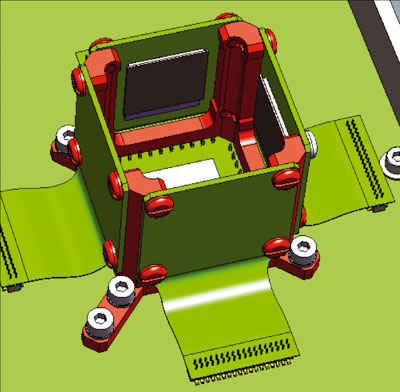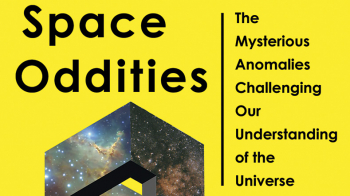Teacher Becky Parker talks about how her school is making it “cool”.

Image credit: Simon Langton Grammar School.
School is where students study what is in textbooks and university is where they start doing research. Or so most people think. It therefore comes as a surprise to discover that teenagers still at school can participate in a research programme that allies space science and earth science. While sceptical educators would argue that in a normal situation teachers have no time, energy, motivation or money for such projects, Becky Parker at Simon Langton Grammar School in the UK has proved that the opposite can be true.
Inspired during a visit to CERN in 2007, she decided to bring leading-edge research to her school. Instead of going back with a simple presentation about how CERN works, Becky took back a real detector and started sowing ideas about how to set up a real research programme, which she called CERN@school. Her ideas fell on fertile ground as her school in Canterbury, in the county of Kent, is one of the most active in implementing innovative ways of teaching science in the UK. One of the school’s declared goals is to “provide learning experiences which are enjoyable, stimulating and challenging and which encourage critical and innovative thinking”. Students at Simon Langton Grammar School do not just study science, they do it.
“During one of my visits to CERN, I had the opportunity to meet Michael Campbell of the Medipix collaboration, and his young enthusiastic team,” recalls Becky. “They showed me the Timepix chip that they were developing for particle and medical physics. I thought that something like this could be used in schools for conducting experiments with cosmic rays and radioactivity.”
Cross-collaboration
The Timepix chip is derived from Medipix2, a device developed at CERN that can accurately measure the position and energy of single photons hitting an associated detector. The most recent success of the Medipix collaboration is the Medipix3 chip, which is being used in a project to deliver the first X-ray images with colour (energy) information. Initially designed for use in medical physics and particle physics, the Timepix chip now has applications that include beta- and gamma-radiography of biological samples, materials analysis, monitoring of nuclear power-plant decommissioning and electron microscopy, as well as the adaptive optics that are used in large, ground-based telescopes.
The students at Simon Langton Grammar School use the Timepix chip by connecting it directly to their computer via a USB interface box. “The box was developed by the Institute of Experimental and Applied Physics in Prague,” explains Becky. “They also developed the Pixelman software that we use to read out the data.” The chip and the box have a certain material cost but the software is made available for free by the Medipix collaboration.
Given the simple set-up and its relatively low cost, Becky’s idea can potentially be transferred to many other schools across the UK and elsewhere in Europe. “Collaboration is a key factor in modern research,” confirms Becky. “And, like in a real scientific collaboration, we are going to involve as many schools as possible in our project. We have received funding from Kent to put 10 Timepix chips into the county’s schools to create a network. This will allow us to show students how you do things at CERN and in other big laboratories.”
By setting-up a network, schools will collect large amounts of data on cosmic rays. “In the future we hope to have Timepix detectors in schools across the world. Participating schools will be able to send data back to us because we have powerful IT facilities and we can store large quantities of data,” says Becky. “We know that in other countries, such as Canada, Italy and the Netherlands, there are similar school programmes that collect data on cosmic rays. It would be ideal if we could all join our efforts and integrate all of the collected data together.”
Timepix in space
Nothing is out of reach for Becky’s ambitious teaching methods, not even deep space. In 2008 the school’s students decided to enter a national competition run by the British National Space Centre to design experiments that will fly in space. Next year, Surrey Satellite Technology Ltd will fly the Langton Ultimate Cosmic ray Intensity Detector (LUCID), a cosmic-ray detector array designed by Langton’s sixth-form students, on one of its satellites. “The students are learning so much from working on LUCID with David Cooke at Surrey Satellite Technology Limited and Professor Larry Pinsky from the University of Houston,” says Becky.
In LUCID, four Timepix chips are mounted on the sides of a cube (figure 1). Students have demonstrated that the four chips allow for the largest active area without breaking power and data transmission limits. A fifth chip, mounted horizontally on the base of the cube, will be modified to detect neutrons. LUCID’s electronics, including a field-programmable gate array for read-out, will be on printed circuit boards attached to the chips.

Image credit: SSTL PDR.
The Timepix detectors produced at CERN do not qualify for use in space. “At one of the last stages of the competition, we were told that our project would go through if we could raise the additional £60,000 needed to qualify the Timepix detectors for space,” Becky recalls. Thanks to the support of the South East England Development Agency and Kent County Council the money was found and LUCID could go into space. LUCID will be mounted outside the spacecraft’s fuselage, housed in a 3 mm (0.81 g cm–2) or 4 mm (1.08 g cm–2) enclosure. Components will mostly be on an inside face of the board offering a further 0.25 g cm–2 of shielding. The detector will also have to be qualified to withstand a vibration level of 20 grms.
Under Becky’s plans, data from LUCID will be compared with data collected by detectors installed on Earth, thus providing information about cosmic rays. “We expect terabytes of data each year from space. We will receive support from the UK Particle Physics Grid (GridPP) to use the Grid. It is a whole research package!,” she says.
The CERN@school project is not the only scientific project that Simon Langton Grammar School students are carrying out. “We collaborate with Imperial College on a research project in plasma physics. One of our students won the ‘Young Scientist of the Year’ prize and published a paper in a proper scientific journal. Others participate in a scientific project for the observation of exoplanets using the Faulkes Telescopes in Hawaii and Australia,” says Becky.
In addition the school hosts special projects in biology and in other branches of science, and also has its own research centre, the Langton Star Centre. This facility, still under construction, will have laboratories and training and seminar rooms. “We will be able to train teachers and students from other schools who want to take part in CERN@school and our other projects,” explains Becky. The centre’s website will include pages where data and analysis results from the network of participating schools will be shared.
These innovative teaching approaches benefit both students and teachers. The school’s philosophy is that 30% of the activities carried out must be beyond the official syllabus. The outcome is that the school provides about 1% of the total number of students studying for physics and engineering degrees at British universities. At the same time, motivating the teachers becomes much easier when they have the prospect of participating in real research programmes in collaboration with CERN, for example.

Many young people at school do not know what it would be like to study physics or engineering at university and do forefront research. However, when they get to work with the real scientists, they discover how amazing this is and readily jump aboard ambitious programmes. “If teachers let students take control in these kinds of projects, they will not mess around – they are going to do all of this properly because they know that this is serious stuff,” assures Becky. “With my students, I am quite rigorous. I tell them that they are going to do it like real scientists. And because this is really an amazing thing to be involved with, they do it properly and with a lot of enthusiasm.”
Becky’s attitude to “her” students, whom she calls “sweethearts”, is a far cry from that of teachers who say how difficult it is to control behaviour in schools and motivate students every day. So why is Becky’s experience so different? “I am in a lovely school,” she explains. “The cool thing to do at my school is physics. A 12 year old came to me last year and said: ‘Miss, we would like you to teach us quantum physics’ and so I did it.”
Becky’s initiative to foster the knowledge of “cool” physics in the region includes the “Langton Guide to the Universe”, in which parents are invited to attend physics lectures on modern and exciting physics. “Families come and receive a first input on things like quantum mechanics. Some kids who attended those lectures when they were very young later joined the school and set up the ‘quantum working group’, which produced a guide to how to teach quantum mechanics to the youngest. They have entered a national competition and reached the final.” These are the sort of expectations that you can have when you go to Simon Langton Grammar School. As Becky explains: “Our philosophy is that if students are interested in doing a scientific project, however ambitious, they can come and talk to us. This is your world, take the initiative and make it successful!”
Further reading
For more information about the LUCID project, see www.thelangtonstarcentre.org/.








